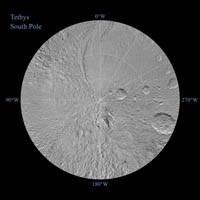
Click on the image for larger versionThe northern and southern hemispheres of Tethys are seen in these polar stereographic maps, mosaicked from the best-available Cassini images.
Each map is centered on one of the poles, and surface coverage extends to the equator. Grid lines show latitude and longitude in 30-degree increments. The scale in the full-size versions of these maps is 293 meters (960 feet) per pixel. The mean radius of Tethys used for projection of these maps is 536.3 kilometers (333.2 miles).
The huge Odysseus Crater (450 kilometers or 280 miles across) can be seen in the upper left of the north pole map, in the northern latitudes between the leading hemisphere and side of Tethys facing away from Saturn. The large Penelope Crater is shown in the lower right of south pole map, in the southern latitudes of the trailing hemisphere of Tethys. See PIA08149 to learn more.
The Cassini-Huygens mission is a cooperative project of NASA, the European Space Agency and the Italian Space Agency. The Jet Propulsion Laboratory, a division of the California Institute of Technology in Pasadena, manages the mission for NASA's Science Mission Directorate, Washington, D.C. The Cassini orbiter and its two onboard cameras were designed, developed and assembled at JPL. The imaging operations center is based at the Space Science Institute in Boulder, Colo.
For more information about the Cassini-Huygens mission visit http://www.nasa.gov/cassini and http://saturn.jpl.nasa.gov. The Cassini imaging team homepage is at http://ciclops.org .

